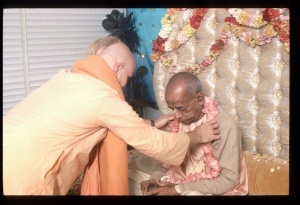CC Madhya 6.144 (1975): Difference between revisions
(Vanibot #0027: CCMirror - Mirror CC's 1996 edition to form a basis for 1975) |
(Vanibot #0020: VersionCompareLinker - added a link to the Version Compare feature) |
||
| Line 2: | Line 2: | ||
<div style="float:left">'''[[Sri Caitanya-caritamrta (1975)|Śrī Caitanya-caritāmṛta (1975)]] - [[CC Madhya (1975)|Madhya-līlā]] - [[CC Madhya 6 (1975)|Chapter 6: The Liberation of Sārvabhauma Bhaṭṭācārya]]'''</div> | <div style="float:left">'''[[Sri Caitanya-caritamrta (1975)|Śrī Caitanya-caritāmṛta (1975)]] - [[CC Madhya (1975)|Madhya-līlā]] - [[CC Madhya 6 (1975)|Chapter 6: The Liberation of Sārvabhauma Bhaṭṭācārya]]'''</div> | ||
<div style="float:right">[[File:Go-previous.png|link=CC Madhya 6.143 (1975)|Madhya-līlā 6.143]] '''[[CC Madhya 6.143 (1975)|Madhya-līlā 6.143]] - [[CC Madhya 6.145-146 (1975)|Madhya-līlā 6.145-146]]''' [[File:Go-next.png|link=CC Madhya 6.145-146 (1975)|Madhya-līlā 6.145-146]]</div> | <div style="float:right">[[File:Go-previous.png|link=CC Madhya 6.143 (1975)|Madhya-līlā 6.143]] '''[[CC Madhya 6.143 (1975)|Madhya-līlā 6.143]] - [[CC Madhya 6.145-146 (1975)|Madhya-līlā 6.145-146]]''' [[File:Go-next.png|link=CC Madhya 6.145-146 (1975)|Madhya-līlā 6.145-146]]</div> | ||
{{CompareVersions|CC|Madhya 6.144|CC 1975|CC 1996}} | |||
{{RandomImage}} | {{RandomImage}} | ||
==== TEXT 144 ==== | ==== TEXT 144 ==== | ||
<div class="verse"> | <div class="verse"> | ||
: | :'apādāna,' 'karaṇa,' 'adhikaraṇa'-kāraka tina | ||
:bhagavānera saviśeṣe ei tina cihna | :bhagavānera saviśeṣe ei tina cihna | ||
</div> | </div> | ||
| Line 25: | Line 24: | ||
<div class="translation"> | <div class="translation"> | ||
"The personal features of the Supreme Personality of Godhead are categorized in three cases-namely ablative, instrumental and locative." | |||
</div> | </div> | ||
| Line 32: | Line 31: | ||
<div class="purport"> | <div class="purport"> | ||
Śrīla Bhaktivinoda Ṭhākura states in his Amṛta-pravāha-bhāṣya that according to the injunction of the Upaniṣads ( | Śrīla Bhaktivinoda Ṭhākura states in his Amṛta-pravāha-bhāṣya that according to the injunction of the Upaniṣads ("the Supreme Absolute Truth is He from whom everything emanates"), it is understood that the whole cosmic manifestation emanated from Brahman, the Supreme Absolute Truth. The creation subsists by the energy of the Supreme Brahman and, after annihilation, merges into the Supreme Brahman. From this we can understand that the Absolute Truth can be categorized in three cases-ablative, instrumental and locative. According to these three cases, the Absolute Truth is positively personified. In this connection, Śrīla Bhaktisiddhānta Sarasvatī quotes the Aitareya Upaniṣad (1.1.1): | ||
::ātmā vā idam eka evāgra āsīn nānyat kiñcana mīṣat sa īkṣata lokān nu sṛjā iti. | |||
Similarly, in the Śvetāśvatara Upaniṣad (4.9) it is stated: | |||
::chandāṁsi yajñāḥ kratavo vratāni | |||
::bhūtaṁ bhavyaṁ yac ca vedā vadanti | |||
::yasmān māyī sṛjate viśvam etat | |||
::tasmiṁś cānyo māyayā sanniruddhaḥ | |||
And in the Taittirīya Upaniṣad (3.1): | |||
::yato vā imāni bhūtāni jāyante, yena jātāni jīvanti, yat prayanty abhisaṁviśanti, tad vijijñāsasva, tad brahma. | |||
: | This was the answer given by father Varuṇa when questioned by his son Vāruṇī Bhṛgu about the Absolute Truth. In this mantra, the word yataḥ, the Absolute Truth from which the cosmic manifestation has emanated, is in the ablative case; that Brahman by which this universal creation is maintained is in the instrumental case (yena); and that Brahman into which the whole cosmic manifestation merges is in the locative case (yat or yasmin). It is stated in Śrīmad-Bhāgavatam ([[SB 1.5.20|1.5.20]]): | ||
:idaṁ hi viśvaṁ bhagavān ivetaro | ::idaṁ hi viśvaṁ bhagavān ivetaro | ||
:yato jagat-sthāna-nirodha-sambhavāḥ | ::yato jagat-sthāna-nirodha-sambhavāḥ | ||
"The entire universal creation is contained in the gigantic form of the Supreme Personality of Godhead. Everything emanates from Him, everything rests in His energy, and after annihilation everything merges into His person." | |||
</div> | </div> | ||
Latest revision as of 18:34, 27 January 2020

A.C. Bhaktivedanta Swami Prabhupada
TEXT 144
- 'apādāna,' 'karaṇa,' 'adhikaraṇa'-kāraka tina
- bhagavānera saviśeṣe ei tina cihna
SYNONYMS
apādāna—ablative; karaṇa—instrumental; adhikaraṇa—locative; kāraka—cases; tina—three; bhagavānera—of the Supreme Personality of Godhead; sa-viśeṣa—in the personality; ei—these; tina—three; cihna—symptoms.
TRANSLATION
"The personal features of the Supreme Personality of Godhead are categorized in three cases-namely ablative, instrumental and locative."
PURPORT
Śrīla Bhaktivinoda Ṭhākura states in his Amṛta-pravāha-bhāṣya that according to the injunction of the Upaniṣads ("the Supreme Absolute Truth is He from whom everything emanates"), it is understood that the whole cosmic manifestation emanated from Brahman, the Supreme Absolute Truth. The creation subsists by the energy of the Supreme Brahman and, after annihilation, merges into the Supreme Brahman. From this we can understand that the Absolute Truth can be categorized in three cases-ablative, instrumental and locative. According to these three cases, the Absolute Truth is positively personified. In this connection, Śrīla Bhaktisiddhānta Sarasvatī quotes the Aitareya Upaniṣad (1.1.1):
- ātmā vā idam eka evāgra āsīn nānyat kiñcana mīṣat sa īkṣata lokān nu sṛjā iti.
Similarly, in the Śvetāśvatara Upaniṣad (4.9) it is stated:
- chandāṁsi yajñāḥ kratavo vratāni
- bhūtaṁ bhavyaṁ yac ca vedā vadanti
- yasmān māyī sṛjate viśvam etat
- tasmiṁś cānyo māyayā sanniruddhaḥ
And in the Taittirīya Upaniṣad (3.1):
- yato vā imāni bhūtāni jāyante, yena jātāni jīvanti, yat prayanty abhisaṁviśanti, tad vijijñāsasva, tad brahma.
This was the answer given by father Varuṇa when questioned by his son Vāruṇī Bhṛgu about the Absolute Truth. In this mantra, the word yataḥ, the Absolute Truth from which the cosmic manifestation has emanated, is in the ablative case; that Brahman by which this universal creation is maintained is in the instrumental case (yena); and that Brahman into which the whole cosmic manifestation merges is in the locative case (yat or yasmin). It is stated in Śrīmad-Bhāgavatam (1.5.20):
- idaṁ hi viśvaṁ bhagavān ivetaro
- yato jagat-sthāna-nirodha-sambhavāḥ
"The entire universal creation is contained in the gigantic form of the Supreme Personality of Godhead. Everything emanates from Him, everything rests in His energy, and after annihilation everything merges into His person."